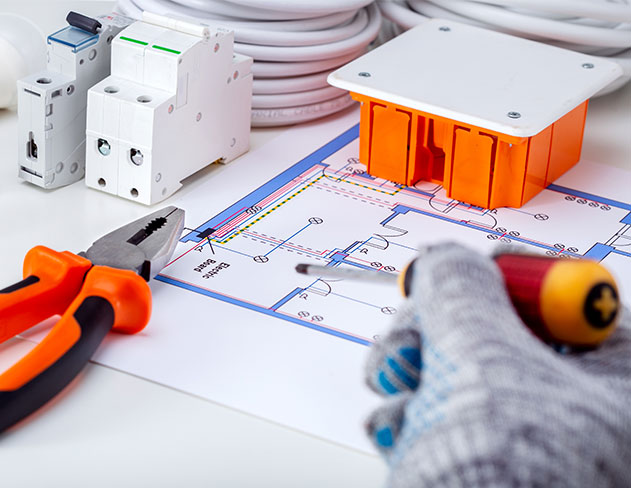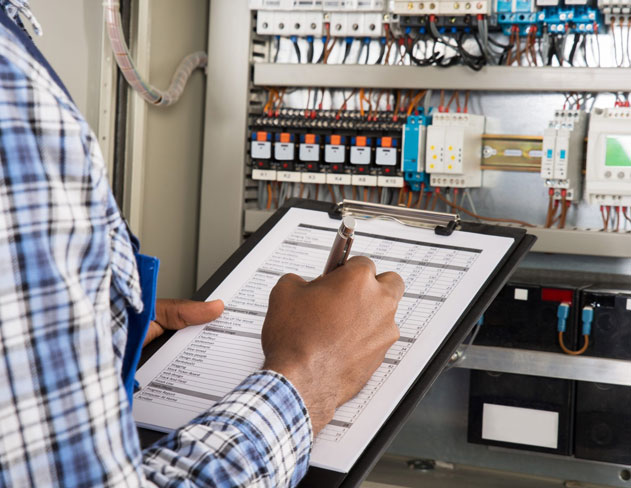Balance Costs with Compliance:
Electrical installation condition reports (EICR) are critical for the complete management of safety and legal compliance in facilities of all types. An EICR inspection identifies potential electrical faults and non-compliances through visual inspections, testing of circuits and equipment, and thorough reporting. Keeping up with regular EICR inspections is mandatory in the UK and essential for minimising fire and electrocution risks.
However, facilities managers often face difficulty reconciling the capital expenditure of comprehensive and frequent EICR inspections with tight operating budgets for building management as energy costs and other factors climb. Finding the optimal balance between safety and spending can be a frustrating challenge, particularly if rental income is uncertain, housing stock fluctuates and operating costs are high.
This article provides expert advice, helpful frameworks and proactive asset management strategies for facilities managers who want to meet EICR compliance obligations cost-effectively. You’ll gain practical budgeting techniques tailored to your unique needs and resources. With some upfront planning and priority targeting, you can achieve full electrical safety for your occupants while maintaining sound financial management.
-
Key Takeaways
- Strategic budgeting requires assessing portfolio-wide needs, mapping multi-year inspection schedules, incorporating reasonable contingencies, and continually pursuing efficiency gains. This balances costs and compliance.
- Optimise scheduling around occupancy fluctuations, seasonal contractor availability, bundled testing opportunities, etc. to minimise rates and business disruption during inspections.
- When management of resources is tough, explore phased targeting of the highest-risk areas first while documenting plans for full compliance over reasonable timeframes agreed upon with providers.
- Standardising reports, centralising data access, and sharing documentation judiciously promote accountability, inform capital planning, and bolster safety reputation.
Understanding What You’re Paying For
To strategise around EICR costs, it’s important to understand what these mandatory inspections entail. The law requires that all public buildings, commercial rental properties, and common areas of flats undergo electrical safety testing on a 5-year cycle. And yes, even a vacant property needs an EICR. The specific requirements and qualifications for the inspector may vary, and it’s always best to get legal advice if you’re not sure.
An EICR will identify, classify, and record any deficiencies found based on statutory safety standards. This allows facilities managers to accurately gauge risks, plan repairs accordingly, have complete management and understanding of the state of the property, and have documented proof of due diligence. Some key benefits of taking a proactive monitoring approach with regular EICRs include:
- Safer operating conditions and reduced risk of fires, equipment damage, or injuries from faults
- Early detection of potential issues prevents future complications and helps with future-proofing properties
- Ensured regulatory compliance and liability protection
- Informed maintenance planning and capital budgeting for efficient management
- Potential insurance discounts for proven safety management
While EICRs do represent a sizable periodic expense, they are an indispensable component of responsible facilities management strategy. The focus should be on efficient management and controlling operating costs through smart scheduling, selective scoping, contractor discussion, and documentation best practices.
Strategic Budgeting for EICR
When developing your operating budget and business plans for your capital, EICR inspections should be built in as regularly occurring multi-year obligations. While an unpredictable expense may crop up occasionally, you can implement a structured approach to forecasting and meeting most EICR needs cost-effectively. Follow this step-by-step process:
Step 1: Assessing Your Needs
Take stock of your portfolio’s size, buildings’ ages, electrical equipment inventories, any recent upgrades, and usage patterns. Consider areas of highest traffic/equipment utilisation. This diligent scoping helps tailor EICR inspection extensiveness to your facilities’ particular profiles. Balance coverage with efficiency to avoid over or under-inspection. Define any high-risk zones and key issues needing custom focus as well.
Step 2: Budget Planning
Map out a tentative 3-5-year inspection schedule balancing internal resource availability and external monitoring services contractor coordination. Factor in regular inspector rates plus incidental repair budgets. Management of renewals and regular checks helps create an inspection checklist covering all statutory requirements to obtain accurate quotes. Revisit this plan annually and adjust timelines or scope based on any changes, for example, if there’s a common issue that keeps cropping up which you can plan for. You may also have specific requirements like needing thermographic surveys
Step 3: Cost-Saving Measures
Look for ways to enhance productivity using technology like infrared thermography, integrated testing equipment, mobile reporting apps, and asset tagging. Bundle inspections where sensible, negotiate discounted multi-site contracts, explore seasonal rate incentives, and optimise travel/staff time. Strategic coordination between your building management team and vendors can yield real savings.
Smart Scheduling to Minimise EICR Costs
While following a consistent EICR schedule is important, facilities managers can leverage small windows of opportunity for extra savings. Consider timing inspections to align with periods when buildings experience lower occupancy or usage. For example:
- Schedule summer/holiday inspections in school buildings when off-peak
- Utilise project off-hours for venues between major events
- Coordinate testing during weekday mornings for office buildings
This minimised business disruption and also limits overtime necessary for accompanying maintenance staff. However, it is important to remember that testing at weekends will be more expensive.
Leveraging Limited Resources for Maximum EICR Compliance
Facilities managers in smaller organisations or those with strict budget constraints may struggle with the management of resources to fund comprehensive EICRs as frequently as preferred. When working with limited resources, employ these strategies for responsible compliance:
Prioritise and Phase
While 100% site coverage every cycle may be ideal, it is not always feasible. Alternate focus between the most critical building areas and higher-risk equipment across cycles. Schedule in phases spread over years to lighten the annual load.
Explore Third-Party Funding Options
Some municipalities offer grants, loan agreements or subsidised safety inspections to fill gaps for community organisations like schools or social services. Research non-profit assistance options to see if this is a credible option for you.
Be Honest About Your Financial Situation
Be upfront about budget pressures and discuss ways to configure service agreements around your situational needs without quality compromise through flexibility or payment plans. You can ask for a cost estimate, including the potential for additional costs, and a trustworthy vendor will always be upfront with you.
The key is open dialogue to find the optimal balance between safety and resources. Monitoring only the most potentially hazardous areas more regularly can be a reasonable interim solution as well. We’ll give you impartial advice that you can trust.
Documentation
Diligent EICR documentation and reporting is the foundation for cost-effective ongoing management. Thorough inspection reports tracking locations, previous issues, repair details, technician notes, safety categorizations, and photographs are invaluable over time. They allow individual accountability, inform maintenance planning, demonstrate duty of care, and help forecast expenses for future remediation efforts.
Some best practices include:
Standardise Reporting
Implement consistent rating criteria, mandatory tracking fields, and report templates across technicians for continuity across cycles. Your management standards should be high when it comes to this issue.
Centralise Records
Maintain easily accessible master digital folders housing all historical inspection data with management accounts to conveniently inform real-time decisions and long-term strategies.
Share Data Judiciously
Be selective in providing transparent EICR documentation showcasing due safety diligence and prompt remediation of issues. This builds trust with occupants, authorities, insurers, etc to demonstrate that there are no legal issues. This potentially reduces liability pressures and insurance rates.
Conclusion
EICR compliance demands can certainly present facilities managers with pressing budget dilemmas. However, this should not deter you from forging an ambitious electrical safety strategy customised to your unique building portfolio and risk profile.
With some diligent assessment of needs, adaptable long-term planning, cost mitigation effort, and the right documentation disciplines – you can achieve full legal EICR conformance without breaking the bank through compromise. At Hexo Electrical Testing, we can talk you through everything that you need to know and help you find the testing package that’s right for you. Get in touch with our expert team to ensure that you’re compliant and to schedule a cost-effective test that gets you where you need to be.
Frequently Asked Questions
Q: How often do I need to conduct EICR inspections?
A: The legal requirement for most public and commercial facilities is every 5 years. However, higher-risk buildings may warrant more frequent inspections, such as every 3 years. Check your exact regulations.
Q: Who should perform the EICR inspections?
A: Always select a qualified, licensed electrician with the proper EICR credentials. Verify their expertise, insurance coverage, and reputation with past clients, and inspect sample reports when choosing between vendors.
Q: What elements does an EICR inspection cover?
A: A comprehensive EICR will involve close visual scrutiny of wiring, breakers, fixtures, appliances, meters, and key system components checking for defects, testing circuits under normal and fault conditions, thermal imaging scans, and thorough reporting.
Q: Can I schedule EICRs only for high-priority areas of my facility to save money initially?
A: While phasing inspections by risk zone can offer small facilities some relief, you should develop a plan to achieve site-wide compliance within a reasonable timeframe as required legally.
Q: Where should I keep EICR reports for easy future access?
A: Maintain well-organised digital copies on both your company servers and cloud-based storage for reliability. Grant access to all on the core facilities team.

